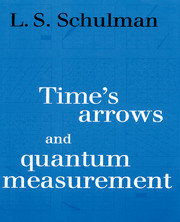Book contents
- Frontmatter
- Contents
- Preface
- 1 Introduction
- 2 Irreversibility
- 3 Arrows of time
- 4 Correlating arrows of time
- 5 Two-time boundary value problems
- 6 Quantum measurements: cats, clouds and everything else
- 7 Existence of special states
- 8 Selection of special states
- 9 Abundance of special states
- 10 Experimental tests
- 11 Conclusions and outlook
- Author index
- Index
6 - Quantum measurements: cats, clouds and everything else
Published online by Cambridge University Press: 05 August 2012
- Frontmatter
- Contents
- Preface
- 1 Introduction
- 2 Irreversibility
- 3 Arrows of time
- 4 Correlating arrows of time
- 5 Two-time boundary value problems
- 6 Quantum measurements: cats, clouds and everything else
- 7 Existence of special states
- 8 Selection of special states
- 9 Abundance of special states
- 10 Experimental tests
- 11 Conclusions and outlook
- Author index
- Index
Summary
Quantum measurement theory addresses several problems. All of them arise from applying a microscopically valid theory to the macroscopic domain. The most famous is the Schrödinger cat example in which the ordinary use of quantum rules suggests a superposition of macroscopically different states, something we do not seem to experience. Another problem is the Einstein-Podolsky-Rosen (EPR) paradox in which a fundamental quantum concept, entanglement, creates subtle and non-classical correlations among remote sets of measurements. Although it seems mere word play to observe that such an apparent micro-macro conflict ought to be viewed as a problem in statistical mechanics—by virtue of the way that discipline is defined—until recently the importance of this observation was seldom recognized.
The founders, Bohr, Schrödinger, Heisenberg, Einstein did not emphasize this direction, but over the years the realization that measurement necessarily involves macroscopic objects—objects with potentially mischievous degrees of freedom of their own—began to be felt. For me this was brought home by the now classic fourth chapter of Gottfried's text on quantum mechanics. He takes up the following problem. The density matrix ρ0 for a normalized pure state is ρ0 = |ψ〉 〈ψ|. It follows that Tr ρ0 = Tr ρ02 = 1. After a non-trivial measurement, the density matrix ρ is supposed to be diagonal in the basis denned by the measured observable, with Tr ρ = 1 but Tr ρ2 < 1.
- Type
- Chapter
- Information
- Time's Arrows and Quantum Measurement , pp. 195 - 224Publisher: Cambridge University PressPrint publication year: 1997



